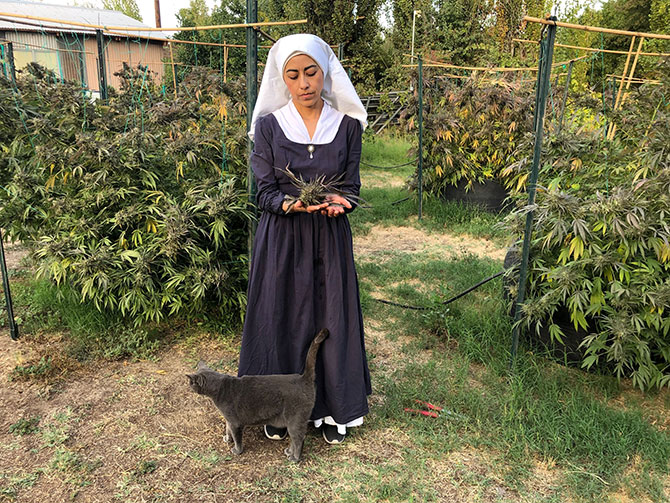Not Sure Where to Start?
Discover what works best for your body and lifestyle—whether you’re exploring for the first time or coming back for your favorites, we’ve got you covered.
Halloween, also known as All Hallows’ Eve, has ancient roots that extend far beyond the tacky ten-dollar costumes and the societal quest for early diabetes. The holiday originated from the Celtic festival of Samhain, which marked the end of the harvest season and the beginning of winter. The Celts believed that on this night, the night of October 31st, the veil between the living and dead is thinnest, allowing spirits to cross over into the mortal realm and for those on the mortal realm, to peer through the veil to the spirits of their ancestors.
In some cultures, fires are built to ward off wandering spirits; people disguise themselves in costume in order to be unrecognizable to the spirit realm. In other cultures, the people would not don disguises, as the point of the night is for their ancestors to recognize them.
The Roman Empire’s conquest of Celtic lands led to the fusion of Samhain with two Roman festivals: Feralia, a day to honor the dead, and Pomona, a festival celebrating the Roman goddess of fruit and trees. As a result, Halloween evolved to include elements of honoring the deceased (the spooky skull and crossbones) and celebrating the bountiful harvest (the happy pumpkin).
European Influence
Halloween was carried to the Americas by European immigrants, particularly Irish and Scottish immigrants who brought their customs and traditions with them. Over time, these practices intermingled with Native American and African traditions, creating a diverse blend of cultures.
Mexican Influence
One of the most notable multicultural aspects of Halloween is its association with the Mexican holiday Dia de los Muertos (Day of the Dead). Dia de los Muertos, which coincides with All Saints’ and All Souls’ Days, is a vibrant celebration of deceased loved ones. Families build altars, or ofrendas, to honor and remember the departed, and decorate them with marigolds, sugar skulls, and the deceased’s favorite food and drinks. This Mexican tradition has significantly influenced the way people in the United States commemorate their own deceased loved ones during Halloween.
Catholic Influence
All Souls Day, celebrated on November 2nd, is a Catholic holiday dedicated to honoring the departed souls and praying for their salvation. It follows All Saints’ Day, which is observed on November 1st and commemorates all the saints, known and unknown.
The connection between Halloween and All Souls Day lies in their proximity on the calendar. Halloween, as All Hallows’ Eve, serves as the evening before All Saints’ Day, while All Souls Day follows, creating a three-day period of remembrance and reflection.
In some regions, the influence of All Souls Day can be seen in Halloween customs. For instance, in parts of Ireland, people light candles in windows to guide the spirits of the departed. This practice reflects the Catholic tradition of lighting candles for the souls in purgatory on All Souls Day.
Not Sure Where to Start?
Discover what works best for your body and lifestyle—whether you’re exploring for the first time or coming back for your favorites, we’ve got you covered.
Native American Tribal Rituals
Halloween is not traditionally part of Native culture, but the basis of their beliefs and the walk they walk every day, includes the following aspects that other cultures celebrate this one time of year. Those include (1) honoring and respecting one’s ancestors (2) honoring and respecting nature (3) honoring the people and accomplishments (like harvest) through tribal celebrations (festivals). Native American cultures place a strong emphasis on nature and demonstrate its significance in their rituals.
In regard to Halloween and All Saint’s Day, it is important to note that a large percentage of most Native American peoples are Christian, or descendants of Christians and, thus, have adopted the All Saint’s holy day and Halloween along with it.
The Dead Supper, also known as the Dumb Supper or the Feast of the Dead, is a solemn and profound ritual held during the celebration of Samhain and happens to be the ritual much favored by the Sisters. The Dead Supper is a deeply spiritual and reflective practice that focuses on honoring and connecting with one’s ancestors and departed loved ones.
Origins of the Dead Supper
The Celtic festival of Samhain, which marked the end of the harvest season and the beginning of winter, is where the Dead Supper tradition originated. Samhain is a time when the veil between the living and the dead is believed to be at its thinnest. During this period, the Celts, particularly in Ireland and Scotland, held the Dead Supper as a way to invite and honor the spirits of their ancestors.
The core idea behind the Dead Supper is to set a place at the table for deceased family members and loved ones. In some variations of the ritual, a place setting might include an empty chair, a plate of food, and a lit candle. The purpose is to create an inviting space where the spirits of the deceased are welcomed and can join the living for a meal, even if it is in a symbolic or spiritual sense.
The Dead Supper is predominantly associated with Celtic traditions, but similar practices of ancestor veneration can be found in various cultures around the world. Two already discussed, include Dia de los Muertos (Day of the Dead) – Mexico and the Catholic tradition of All Saints’ and All Souls’ Days every year at Samhain.
In addition, the Dead Supper is a tradition in Chinese culture via the Qingming Festival. The Qingming Festival, also known as Tomb-Sweeping Day, is a time when Chinese people honor their ancestors by visiting their graves, making offerings, and burning incense. This tradition demonstrates a strong connection to ancestral veneration.
And in East Asia, there is the Hungry Ghost Festival – In many East Asian cultures, such as China, Taiwan, and Vietnam, the Hungry Ghost Festival is celebrated to honor and appease the spirits of the deceased. People leave offerings of food and burn incense to ensure that their ancestors are not suffering in the afterlife.
In each of these cultural traditions, the underlying theme is a connection with the deceased and a belief in the presence of spirits during certain times of the year when the boundary between the living and the dead is believed to be more permeable. While the specifics and rituals may vary, the core idea of showing respect and maintaining a connection with one’s ancestors is a common thread. The Dead Supper is a beautiful and poignant tradition that exemplifies the importance of honoring and recognizing one’s ancestors during Samhain, a time when the veil between worlds is thought to be at its thinnest, allowing for a profound connection between the living and the dead.
Not Sure Where to Start?
Discover what works best for your body and lifestyle—whether you’re exploring for the first time or coming back for your favorites, we’ve got you covered.







Comments are closed.